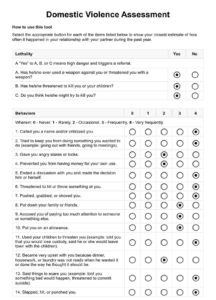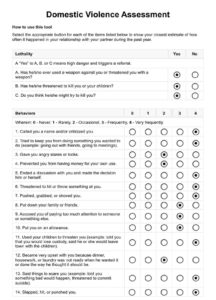Understanding and addressing domestic violence is a critical endeavor that requires immense sensitivity and a robust approach. When organizations, researchers, or support groups aim to gather data, assess needs, or evaluate interventions, the tools they use are paramount. A well-constructed survey isn’t just a list of questions; it’s a bridge to understanding experiences, identifying patterns, and ultimately, informing effective strategies for prevention and support.
Given the deeply personal and often traumatic nature of domestic violence, the design of any data collection instrument must prioritize safety, empathy, and ethical considerations above all else. This isn’t just about ticking boxes; it’s about creating a safe space for individuals to share their stories, ensuring their privacy, and providing pathways to help. Crafting a professional survey template for domestic violence requires a thoughtful balance of rigorous methodology and compassionate understanding.
Why a Specialized Survey Template is Crucial for Sensitive Data
Collecting information about domestic violence isn’t like surveying customer satisfaction. It involves delving into experiences that are often shrouded in secrecy, fear, and profound emotional pain. A generic survey template simply won’t suffice. The nuances of coercive control, various forms of abuse (physical, emotional, financial, sexual), and the complex dynamics of abusive relationships demand a tailored approach. Without a specialized, carefully designed template, you risk retraumatizing individuals, gathering incomplete or inaccurate data, and ultimately undermining the very purpose of your research or support efforts.
Furthermore, the legal and ethical implications surrounding domestic violence data are significant. Ensuring confidentiality, providing clear informed consent, and understanding mandatory reporting laws are not optional extras; they are fundamental requirements. A professional survey template helps to build these critical safeguards into its structure, protecting both the participants and the organization conducting the survey. It acts as a framework that guides data collection in a way that is respectful, ethical, and legally compliant.
Imagine the difference between asking “Have you been hurt?” versus a series of questions that gently explore different forms of harm, the frequency, and the context, while also offering immediate support resources. This latter approach, facilitated by a professional template, demonstrates an understanding of trauma and promotes a safer environment for disclosure. It allows for a more comprehensive and accurate picture of the violence experienced, which is essential for developing effective interventions and advocacy initiatives.
Key Components of an Effective Template
- Safety and Confidentiality Protocols: Clearly outlining how data will be protected, ensuring anonymity where possible, and providing information about how to stop the survey at any point or seek immediate help.
- Trauma-Informed Language: Using neutral, non-judgmental, and empathetic language that avoids victim-blaming or triggering responses. Questions should be phrased to empower, not re-victimize.
- Comprehensive Question Categories: Covering various forms of abuse (physical, emotional, psychological, financial, sexual, digital), frequency, duration, impact on daily life, and barriers to seeking help.
- Skip Logic and Branching: Designing the survey to adapt based on previous answers, so participants only see relevant questions, reducing survey fatigue and irrelevance.
- Resource Provision: Integrating prominent links or information for local and national domestic violence hotlines, support organizations, and safety planning resources directly within the template.
- Informed Consent: A clear, understandable statement outlining the purpose of the survey, data usage, risks, benefits, and the voluntary nature of participation.
By incorporating these elements, a survey transforms from a mere questionnaire into a thoughtful instrument for change. It signals to participants that their experiences are valued, and their safety is paramount, fostering a greater likelihood of honest and complete responses.
Crafting Your Professional Survey Template for Domestic Violence: Best Practices
Developing a professional survey template for domestic violence is an iterative process that benefits greatly from collaboration. It is highly recommended to involve domestic violence advocates, survivors (if appropriate and safe for them), researchers, and ethical review boards in the design phase. Their insights can provide invaluable perspectives on question phrasing, cultural sensitivity, and the practicalities of survey administration in real-world settings. This collaborative approach ensures the template is not only methodologically sound but also deeply empathetic and relevant to the lived experiences of those affected by abuse.
When formulating questions, prioritize clarity and avoid jargon. Think about whether open-ended questions might provide richer qualitative data for certain areas, while multiple-choice or Likert scales can efficiently capture quantitative trends. It’s crucial to steer clear of leading questions that might influence a participant’s answer or imply judgment. The goal is to elicit honest and uncensored responses, not to confirm preconceived notions. Remember, the way a question is asked can significantly impact the quality and trustworthiness of the data collected.
Before deploying any survey widely, pilot testing is an absolute must. Test the template with a small, representative group (perhaps individuals with relevant experience, though not necessarily survivors directly if it poses a risk) to identify any confusing language, technical glitches, or areas where the survey might be insensitive or triggering. Gather feedback on the length, flow, and overall user experience. This vital step allows for necessary revisions and refinements, ensuring that the final professional survey template for domestic violence is as effective and safe as possible.
- Collaborate with experts: Engage domestic violence advocates, social workers, and survivors in the design process to ensure relevance and sensitivity.
- Prioritize participant safety: Implement features that allow participants to quickly exit the survey, hide their screen, or access immediate support if needed.
- Ensure anonymity and confidentiality: Clearly communicate how personal data will be handled and protected to build trust.
- Use trauma-informed language: Avoid accusatory or judgmental phrasing; focus on neutral, empathetic communication.
- Offer clear exit strategies and support resources: Embed links to helplines and support organizations directly within the survey for immediate access.
- Regularly review and update: Domestic violence dynamics can change, and new insights emerge; templates should be periodically reviewed and updated.
A well-designed template is a dynamic tool that adapts to new understanding and evolving needs. It’s not a static document but a living instrument that can be refined over time to better serve its purpose.
The creation and implementation of a thoughtfully designed survey are pivotal steps in the ongoing effort to combat domestic violence. By meticulously crafting instruments that respect the dignity and safety of individuals, we can gather the essential data needed to understand the scope of the problem, identify areas for improvement in support services, and advocate for more effective policies. These insights are invaluable for organizations dedicated to prevention, intervention, and healing.
Ultimately, a strong survey tool empowers both the data collector and the participant. For those collecting information, it provides a structured and ethical pathway to critical understanding. For those sharing their experiences, it offers a safe and confidential avenue to contribute to a larger cause, knowing that their voices are heard and can lead to meaningful change in the lives of others experiencing similar challenges.



